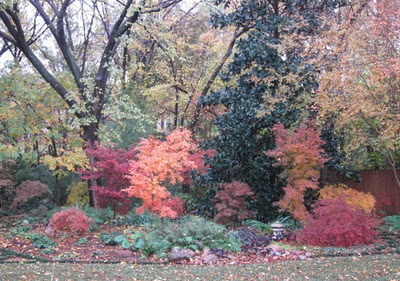"X" is for...
jet trails over DFW Airport?
jet trails over DFW Airport?
As I was thinking about what word I would use for the letter X, I immediately thought of Xeriscape. But that is so predictable. So I went exploring online for gardening terms that begin with X. With all of the new terms I learned, I think I just might be going into the new year a little bit smarter :-)
You've heard of chlorophyll, no doubt, but have you heard of xanthophyll? Xanothophyll is a substance causing the yellow color of autumn leaves. The yellow coloration is masked by the presence of chlorophyll, and xanthophylls are only revealed when chlorophyll is degraded as the plant heads into dormancy.
These yellow pigments are also observed in leaves with certain nutrient deficiencies, such as chlorosis. Thankfully I did not have a lot of examples of chlorosis in my garden, but I did find these chlorotic 'Nana' Nandina leaves that were certainly showing off their xanthophylls.
The picture below shows how Nandina foliage should look in the winter.
Ah, yes, that's much better...
Also from the combining word xantho (Greek xanthos, meaning "yellow"), we get Xanthocarpous, which means "having yellow fruit," and Xanthospermous, which means "having yellow seeds."
Xenogamy means "cross-fertilization."
Xylem means the "woody portion of a plant."
X is also for Xenolith, "a fragment of extraneous rock embedded in magma or another rock." I wonder if these might be considered examples of xenoliths in a few of my garden rocks.
Xiphophyllous means "having sword-shaped leaves." Do you think the leaves of this Red Cordyline and the Hymenocallis 'Tropical Giant' fit the bill?
And, yes, from the combining word xero (Greek xeros, meaning "dry"), we get all kinds of garden terms, not the least of which is our old friend Xeriscape.
Xeriscaping is "a method of landscaping that uses drought-resistant plants that are well adapted to a local area. Xeriscaping is often used as a water conservation strategy." Since I do supplemental watering of my garden, I am not sure it would qualify as a true xeriscape garden, but I do use "drought-resistant plants that are well adapted to my local area."
Xeric means "dry; lacking in moisture."
Xerothermic means "dry and hot."
Xerophilous means "growing in or adapted to especially dry and hot regions."
Xerophytic means "able to withstand drought."
Xerophobous means "unable to survive drought."
Every summer in Texas is xeric and xerothermic, and most of my plants are xerophilous and xerophytic. But during the extremely xeric summer of 2011, I thought I was becoming a little xerophobous at times!
And then finally Xanthippe, which means "an ill-tempered woman." If I don't get to dig in the dirt at least a few times a week, I guess I could become a xanthippe! I think my New Year's resolution should be to never become a xanthippe :-)
Moving on...
"Y"
is for Yew and You
A new plant that I added to my garden this spring is called Spreading Japanese Plum Yew, Cephalotaxus harringtonia 'prostrata.' I love its fine-textured, soft green foliage.
I have a sweep of the yew planted below my Shumard Red Oak and in front of Turk's Cap. Since it was just planted this last spring, right now it is growing very close to the ground and is only 2 to 3 feet wide, but it will eventually grow to about 2 feet tall and 5 feet wide. The goal is that it will grow just tall enough to grace the top edge of the boulders to soften the hardscape.
Y is also for YOU!
I am looking forward to another year of blogging about this little plot of land I have been given the blessing to care for, and I hope you will continue to join me on my garden blogging adventures in the new year.
And finally...
"Z"
is for Zexmenia
Speaking of xeric plants, let me sing the praises of this native Texas plant once again before the year is out. If there was ever a summer for this plant to show its stuff, it was the summer of 2011 for sure! Tiny bright yellow blooms cover this extremely drought-tolerant plant all summer long.
And that's it.
I hope you have enjoyed this trip through my garden...
from A to Z.
from A to Z.
To view the other posts in this series, click here
Happy New Year!!!
Toni :-)






















































